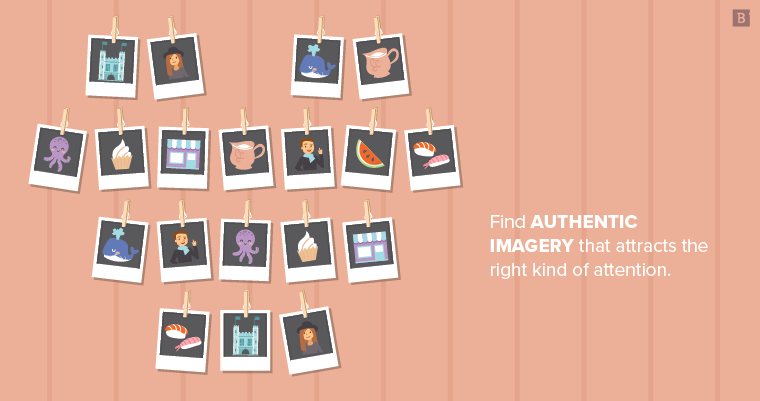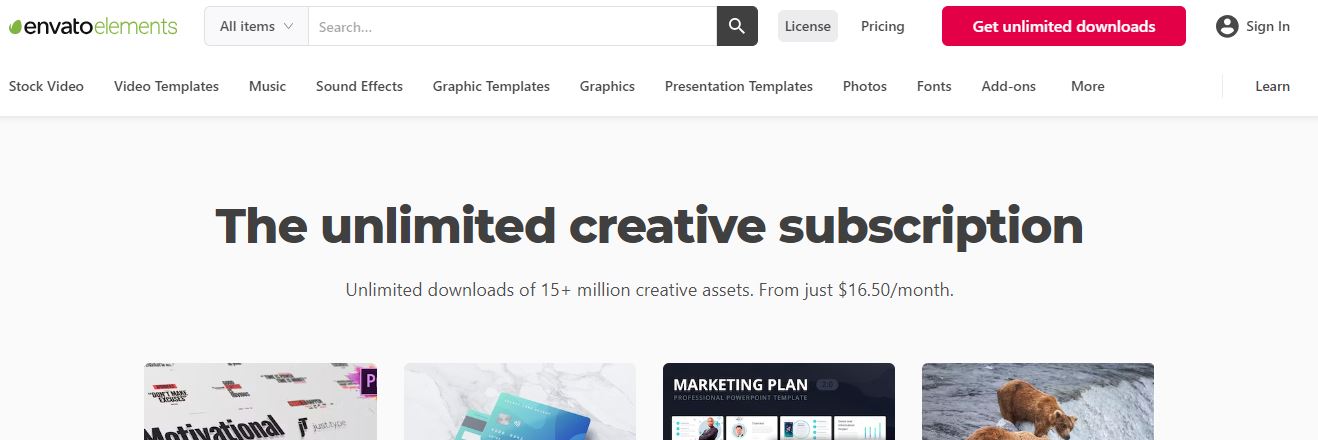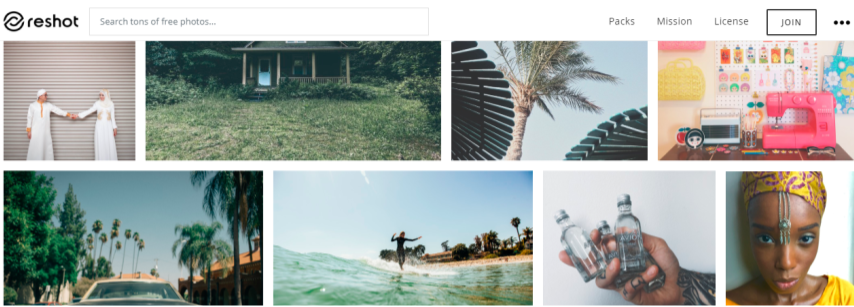Awkward. Cheesy. Stiff. Staged. Tacky.
Yep, that about sums up stock photography.
We’ve all seen our fair share of unfortunate stock images, and the repeated experience leaves many of us with a bad taste in our mouths. The photography angels among us turned this frustration into digital image libraries with far better options.
It’s true – there are stock photography providers that offer authentic and engaging imagery that won’t scream “stock photo” to your audience. And that’s what makes them the best stock photo sites available to marketers today.
The undeniable importance of photography in marketing
To put it bluntly, a content marketing plan that doesn’t include visual elements would have a hard time ever getting off the struggle bus. We know that people are inherently visual, and shrinking attention spans only put more pressure on marketers to communicate messages quickly and creatively.

Images are integral to marketing content because they break up long chunks of copy, making the prospect of reading and comprehending the information far less daunting. What’s more, they actually enhance the message the copy is trying to get across and help people process information at faster speeds. By capturing and maintaining audience attention, images can significantly boost content performance.
As much as we would all love to use exclusively original photography, most brands don’t have the time or resources to snap photos for every single piece of content. And that, my friends, is why stock photography websites exist. It’s up to marketers to find the best stock photo sites for their needs and then search those galleries for winning photos that align with their content.

The rules and regulations of stock photography
Before we start naming stock images sites, it’s important to note that there are some copyright rules to follow when you use someone else’s photography. The perk of most stock photo websites is that they offer images in the public domain, which essentially means you can download, copy, modify and distribute the photos for personal or commercial use without asking for permission or attributing the photographer.
Brands generally err on the side of caution, avoiding photos that aren’t in the public domain because using them could cause potential legal issues. Some stock photo websites offer images that require attribution, so be careful when selecting your photos.
As far as marketing rules and regulations go, there are some stock photography best practices you can follow:
- Visuals should enhance the message: Use images that help viewers understand the point you’re trying to get across. Random images will just confuse them.
- Stay on brand: Even the images you use contribute to your brand voice and personality.
- Complement the platform: The stock photos you use for Instagram posts won’t necessarily be the same ones you use for blog posts. At the very least, make sure the image size and quality is appropriate for its platform destination.
- Quality over quantity: Your audience won’t be impressed with low-quality images.
- Common sense prevails: If you’re marketing beachside living in Florida, don’t use a stock photo that was clearly taken in the Bahamas. Those little details can make or break how authentic your messaging feels to viewers.
All that’s left to do now is find those winning photos.
The stock photo sites to know
See ya later cheesy – these stellar stock photo sites have got the goods:
Twenty20

Home to over 45 million crowd-sourced photos, Twenty20 prides itself on its collection of authentic stock photography. It’s a great option for large companies with robust marketing, social media and design needs – along with room in the budget for a paid service.
The price tag: You can start with a free trial, but then you’re looking at plans starting at $29/month for unlimited photos. You can also contact them if you’re interested in a more enhanced enterprise plan.
The good: It’s a huge collection of Instagram-worthy images (which is saying something, considering we all know Instagram is the gold standard for photos). Plus, some brands you may recognize use Twenty20, including Amazon, Google, Hulu, YouTube, Lyft, The Weather Channel, AARP and TripAdvisor.
The not-so-good: Not all Twenty20 images are approved for commercial use. You have to be careful to look for the green checkmark before selecting a photo, although you can filter the search results to display only images you can use for commercial or editorial use.
Death to Stock

Founded by two photographers who know the struggle of finding images that aren’t awkward, boring or overused, Death to Stock is a photo library membership for creatives who are looking for something different. The crew of professional photographers snaps and edits a curated collection of photo packs that they send to their members each month.
The price tag: There’s a free membership, which is limited to the monthly emails and a sampling of media. For access to exclusive imagery and a searchable archive, you can choose from two membership options: one at $12/month and another for $21/month. The former is designed for small businesses and start-ups, while the latter generally suits agencies and freelancers.
The good: The site has a do-what-you-want license, which means you don’t have to worry about use restrictions. We also love that Death to Stock uses a percentage of the membership fees to help fund artist projects around the world.
The not-so-good: While you get a curated batch of high-quality photos delivered to your inbox each month, you may need to supplement the subscription with another stock photo site if your strategy calls for a larger amount or more varied supply of images.
Envato Elements

If you’re tired of seeing the same photo of a smiling girl holding a salad bowl, be sure to check out Envato Elements, your one-stop shop for all things creative. With a vast library of over 8.9 million stock photos that grows every day, there’s every chance you’ll find the perfect shot.
The price tag: the individual plan starts at $16.50 per month, but they also have special prices for students and teachers (from $11.50), teams (starting at $14.50) and enterprises (customized). You get unlimited downloads with any of these plans.
The good: if you’re looking for a place to get more than stock photos, Envato Elements is your go-to place. Whether you need presentation templates for your next pitch, special effects for a video campaign or an extensive library of fonts, you’ll find that here. The best part? Their license gives you the rights to use items even in commercial projects.
The not-so-good: if you only need stock photos, Envato Elements can be too much. But hey, why not take advantage of everything they offer?
Negative Space

This royalty-free stock image site offers a digital library of high-resolution photos that you’re free to use however you please. The growing collection spans categories like nature, transportation, architecture, sport and technology. You can simply browse the site or enter your email to get a selection of photos sent straight to your inbox.
The price tag: Great news – these photos are 100 percent free.
The good: All Negative Space photos are available under the Creative Commons CCO license, and the gallery stays fresh with weekly additions to the collection. Plus, a search function allows you to filter results by the photo colors – a mega perk for designers.
The not-so-good: Some of the photos have a desktop wallpaper vibe, which can work for some projects but feel a little too stuffy for others.
Unsplash

With over 900,000 images to choose from, Unsplash boasts a diverse collection of impressive photography generously gifted by creators around the world.
The price tag: Access these premium stock photos absolutely free of charge.
The good: Unsplash adds 10 new photos to the site every 10 days – so the odds are high that you’ll find just the image you have in mind.
The not-so-good: While you’re free to use all the photos as you please, the site does note that photographer attributions are always appreciated. The guilt is real.
Adobe Stock

Adobe offers a vast collection of over 50 million royalty-free photos, videos, design templates, 3D content, illustrations and graphics. This media gallery is ideal for those who already have Adobe Creative Cloud, as it’s included with the subscription and is compatible with Creative Suite applications.
The price tag: If you don’t have Creative Cloud, you can get 10 standard assets a month for $29.99/month. The price goes up if you choose a plan for 40, 350 or 750 assets per month. You can also buy credit packs to purchase content without a monthly plan, as well as non-standard assets like videos.
The good: Adobe uploads new photos on a daily basis, meaning you’ll always be spoiled for choice.
The not-so-good: Unless you use Creative Suite on a regular basis, Adobe Stock can be an expensive option for most marketers’ photography needs.
Pixabay

With over 1.6 million stock photos, illustrations, vectors and videos that exist in the public domain, Pixabay makes it easy to access and use images for commercial projects and editorial purposes.
The price tag: Pixabay is another generous platform offering all this visual content for F-R-E-E.
The good: Lots and lots of high-resolution photos at no charge – what’s not to like?
The not-so-good: You may see “no hotlinking” notes on Pixabay images, which essentially means that the URLs won’t work on external sites. If you want to use the images on your website, for instance, you’ll have to upload them to your server.
Burst (powered by Shopify)

This image library features thousands of high-res images shot by photographers around the world. Burst encourages users to use, edit and distribute the photos as they wish.
The price tag: A big fat zero dollars and zero cents.
The good: Photos available for commercial use with no attribution or payment required? Talk about a sweet deal.
The not-so-good: Burst was created with small business owners in mind, which means a lot of the collection is catered toward e-commerce content. Great for small businesses, but not necessarily right for enterprise companies, B2B businesses or more technical industries.
picjumbo

Viktor Hanacek is a photographer and web designer who understands the need for high-quality photos that tell the right story. He created picjumbo in 2013 with the straightforward goal of sharing photos with the world. Like other photography websites, you can subscribe to the picjumbo newsletter to liven up your inbox with new stock photos.
The price tag: You can access much of the collection for free, although there are premium memberships designed for bloggers, designers and agencies, ranging from about $10 to $40 a month.
The good: With free and paid options, picjumbo is accessible for a multitude of brands. Plus, picjumbo updates the collection with new photos every single day.
The not-so-good: Many users agree that the website design and interface could be better, as searching through the gallery can be quite a tedious process.
Reshot

Self-described as “handpicked, non-stocky images,” this photo library is another great source for far-from-ordinary photography. The site even offers curated quick-image packs for easy access to themed collections of photos.
The price tag: Your marketing budget is safe with Reshot’s free photos.
The good: Thankfully, you won’t find tacky photos here. Even better, all Reshot photos are approved for commercial and editorial use – no attribution necessary.
The not-so-good: While marketed as a free service, Reshot does have sponsored photos in its collection that will redirect users to a partner’s website to purchase the image.
Pexels

Made for designers, bloggers and marketers in need of premium stock photos, Pexels is a carefully hand-picked collection of easily searchable images. Every photo that earns a spot is free for personal and commercial use under the Pexels License.
The price tag: Nada! You don’t have to dip into your budget with this free collection.
The good: New photos make the cut every day, making Pexels an ever-growing photography resource. The search function is also top-notch, allowing you to look for something specific or browse through relevant themes.
The not-so-good: Like Reshot, Pexels also sneaks in their fair share of sponsored photos.
Tread lightly…
There are some stock photography giants worth mentioning – but beware. As the OGs in online photo libraries, they’re partly to blame for the cheesy stock photos we’ve all come to hate. However, they’re still around for a few reasons. One, they have some of the largest stock photo collections available on the internet. Two, they’re ideal for enterprise-level companies. Three, not for nothing, they have updated their galleries with the authentic imagery people are more likely to buy.
You’ve probably heard of these two stock photo giants:
Shutterstock

This site has over 200 million royalty-free images – and over 1.5 million new stock images are added every week. Talk about an utterly massive library of photos. They also have vectors, illustrations, videos and music tracks, which makes the subscription investment more attractive for marketing and advertising agencies. There are several pricing options – from $169 for 350 photos per month to $479/month for 750 photos and team collaboration options.
Getty Images

Like Shutterstock, Getty has a collection of over 200 million royalty-free assets. Pricing ranges from $150 to $500 per month depending on the plan. The company also owns iStock, which has slightly more affordable pricing than Getty’s main site.
RIP bad stock photos
For the love of all things marketing, let’s make a pact to stop using cheap, cheesy and cringe-worthy stock photography. Onward!





